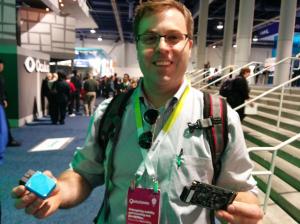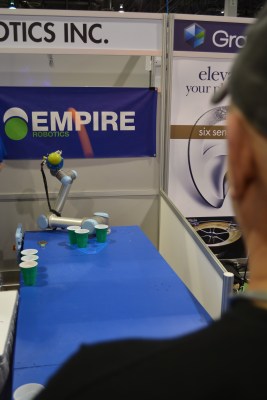My first day on the ground at CES started with a somewhat amusing wait at the Taxi Stand of the McCarran International Airport. Actually I’m getting ahead of myself… it started with a surprisingly efficient badge-pickup booth in the baggage claim of the airport. Wait in line for about three minutes, and show them the QR code emailed to you from online registration and you’re ready to move to the 1/4 mile-long, six-switchback deep line for cabs. Yeah, there’s a lot of people here for this conference.
It’s striking just how huge this thing is. Every hotel on the strip is crawling with badge-wearing CES attendees. Many of the conference halls in the hotels are filled with booths, meaning the thing is spread out over a huge geographic area. We bought three-day monorail passes and headed to the convention center to get started.
Building the Booths

Emotive Insights headsets

Slot-car “brain racing” with scoreboard
[Sophi] knows [Ben Unsworth] who put his heart and soul into this year’s IEEE booth. His company, Globacore, builds booths for conferences and this one sounds like it was an exceptional amount of fun to work on. He was part of a tiny team that built a mind-controlled drag strip based on Emotive Insight brainwave measuring hardware shipped directly from the first factory production run. This ties in with the display screens above the track to form a leader board. We’ll have a keen eye out for hacks this week, but the story behind building these booths may be the best hack to be found.
Oculus

Oculus Gear VX uses a Galaxy Note 4 as the display

Sophi Kravitz trying out Oculus Gear VR
[Ben] told us hands-down the thing to see is the new Oculus hardware called Crescent Bay. He emphatically mentioned The Holodeck which is a comparison we don’t throw around lightly. Seems like a lot of people feel that way because the line to try it out is wicked long. We downloaded their app which allows you to schedule a demo but all appointments are already taken. Hopefully our Twitter plea will be seen by their crew.
In the meantime we tried out the Oculus Gear VR. It uses a Galaxy Note 4 as the screen along with lenses and a variety of motion tracking and user controls. The demo was a Zelda-like game where you view the scene from overhead. This used a handheld controller to command the in-game character with the headset’s motion tracking used to look around the playing area. It was a neat demo, I’m not quite sold on long gaming sessions with the hardware but maybe I just need to get used full-immersion first.
Window to another Dimension

The midways close at six o’clock and we made our way to the Occipital booth just as they were winding done. I’ve been 3D scanned a few times before but those systems used turntables and depth cameras on motorized tracks to do the work. This uses a depth-camera add-on for an iPad which they call Structure Sensor.
It is striking how quickly the rig can capture a model. This high-speed performance is parlayed into other uses, like creating a virtual world inside the iPad which the user navigates by using the screen as if it were a magic window into another dimension. Their demo was something along the lines of the game Portal and has us thinking that the Wii U controller has the right idea for entertainment, but it needs the performance that Occipital offers. I liked this experience more than the Oculus demo because you are not shut off from the real world as you make your way through the virtual.
We shot some video of the hardware and plan to post more about it as soon as we get the time to edit the footage.
Find Us or Follow Us
 We’re wearing our Hackaday shirts and that stopped [Josh] in his tracks. He’s here on business with his company Evermind, but like any good hacker he is carrying around one of his passion projects in his pocket. What he’s showing off are a couple of prototypes for a CANbus sniffer and interface device that he’s build.
We’re wearing our Hackaday shirts and that stopped [Josh] in his tracks. He’s here on business with his company Evermind, but like any good hacker he is carrying around one of his passion projects in his pocket. What he’s showing off are a couple of prototypes for a CANbus sniffer and interface device that he’s build.
We’ll be at CES all week. You can follow our progress through the following Twitter accounts: @Hackaday, @HackadayPrize, @Szczys, and @SophiKravitz. If you’re here in person you can Tweet us to find where we are. We’re also planning a 9am Thursday Breakfast meetup at SambaLatte in the Monte Carlo. We hope you’ll stop by and say hi. Don’t forget to bring your own hardware!
 A couple of years ago he worked on a standalone chemical sensor and had a few extra boards sitting around after the project was done. As any resourceful hacker will do, he reached for them as the closest and easiest solution when needing to log data as a quick test. It wasn’t for quite some time that he went back to try out commercially available loggers and found a problem in doing so.
A couple of years ago he worked on a standalone chemical sensor and had a few extra boards sitting around after the project was done. As any resourceful hacker will do, he reached for them as the closest and easiest solution when needing to log data as a quick test. It wasn’t for quite some time that he went back to try out commercially available loggers and found a problem in doing so.




 Wandering the aisles of Eureka Park, the startup area of the Consumer Electronics Show, I spotted a mob of people and sauntered over to see what the excitement was all about. Peeking over this gentleman’s shoulder I realized he was getting spanked at Beer Pong… by a robot!
Wandering the aisles of Eureka Park, the startup area of the Consumer Electronics Show, I spotted a mob of people and sauntered over to see what the excitement was all about. Peeking over this gentleman’s shoulder I realized he was getting spanked at Beer Pong… by a robot!






 We’re wearing our Hackaday shirts and that stopped [Josh] in his tracks. He’s here on business with his company Evermind, but like any good hacker he is carrying around one of his passion projects in his pocket. What he’s showing off are a couple of prototypes for a CANbus sniffer and interface device that he’s build.
We’re wearing our Hackaday shirts and that stopped [Josh] in his tracks. He’s here on business with his company Evermind, but like any good hacker he is carrying around one of his passion projects in his pocket. What he’s showing off are a couple of prototypes for a CANbus sniffer and interface device that he’s build.









